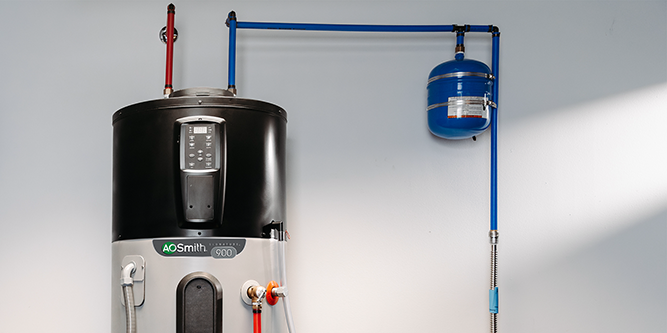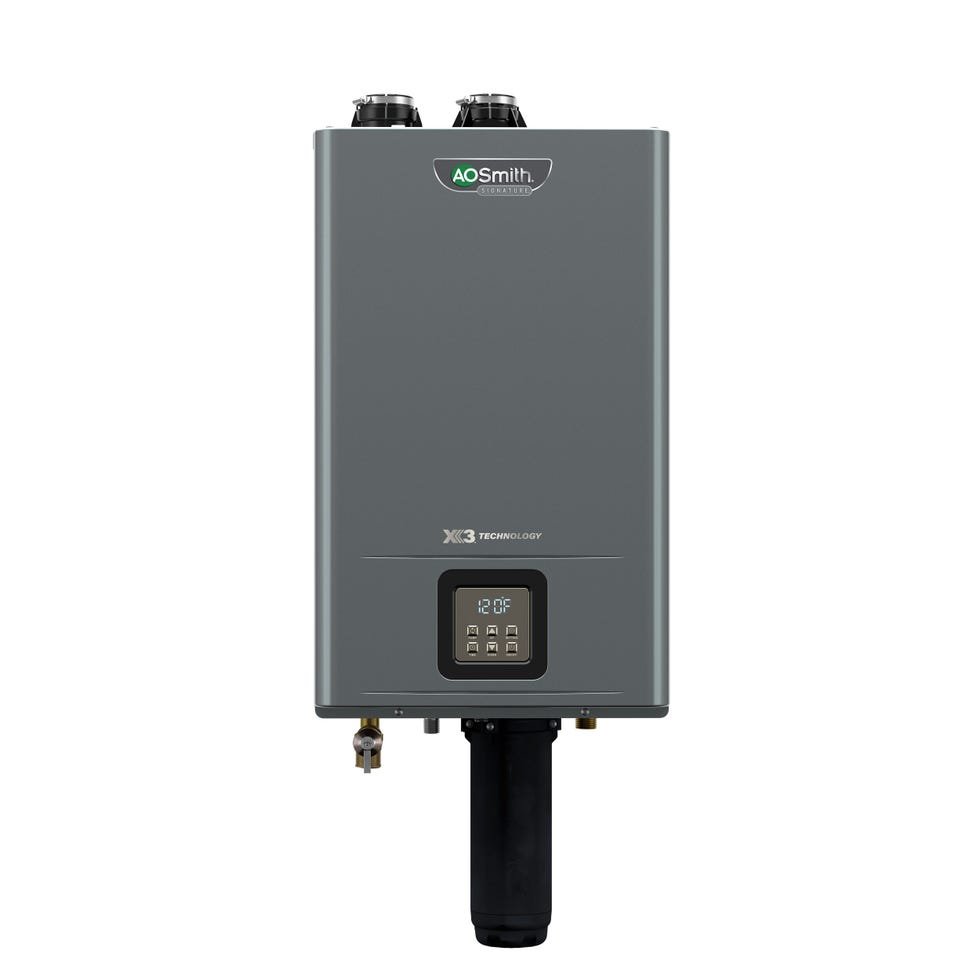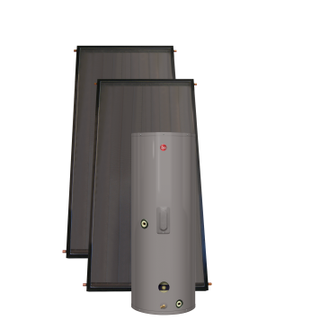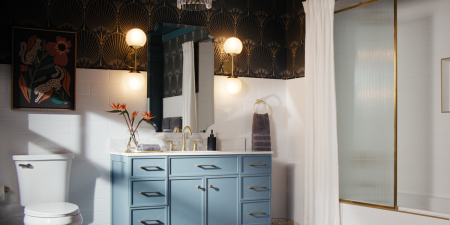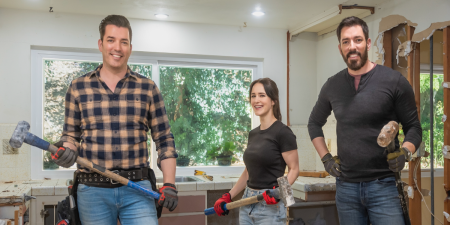Most of us don’t think a lot about our water heater — until that chilly winter morning when you realize the shower’s been running for a few minutes and it’s still not getting hot. Then you can’t think of anything else.
Another reason to pay attention to your water heater: it’s one of the biggest energy users in the home, accounting for nearly 20 percent of the average home’s total energy costs, according to the U.S. Department of Energy.
Our experts in the Home Improvement & Outdoor Lab at the Good Housekeeping Institute pulled together this buying guide to help you get out in front of this critical purchase decision. The advice is based on our experience testing various types of water heaters in recent years, as well as interviews with industry experts, including contractors, home builders and service professionals.
One thing all experts agree on: you don’t want to wait for your current water heater to conk out before replacing it, since you’re more likely to overpay or end up with a less-than-perfect model in that hurried scenario. “Signs that your water heater might be ready for replacement include age (lifespan is typically between 12 and 15 years), inconsistent water temperature, noises emanating from the tank, reduced water pressure and discolored or strange smelling water,” says Francis J. Dietz, Vice President, Public Affairs with the Air-Conditioning, Heating, and Refrigeration Institute (AHRI).
If any of those conditions apply to your water heater, read on for the essentials.
Types of water heaters
While the market is still dominated by storage tank water heaters, even within that conventional category there are more options than ever. Plus, our experts say many newer, high-efficiency technologies might also be worth a look. Here’s how they all stack up.
Storage Tank Water Heater
The most common type of water heater used in about 90 percent of U.S. homes, these units consist of an insulated tank that stores heated water until it’s needed. A pipe at the top of the tank sends water to your home’s plumbing system, where it’s delivered to fixtures and appliances — showers, faucets, the dishwasher, the washing machine and so on. Water is heated either by a gas burner or an electric element, hence the market for electric storage tank water heaters and gas storage tank water heaters.
Electric water heaters are less expensive and easier to install, since they don’t need to be vented to the outdoors, unlike gas water heaters, which produce harmful carbon monoxide. But electricity costs more than natural gas in most parts of the country, making electric water heaters more expensive to operate.
If properly maintained, including annual tune-ups by a service professional, a storage tank water heater should last at least 10 to 12 years.
Pros
- Low upfront cost
- Easy to install, especially electric units
- Fairly easy to maintain
Cons
- Supply of hot water is limited to the size of the tank
- Relatively short lifespan
Cost, including installation
- $900 to $1,800
- Energy Star-qualified gas storage tank water heaters are eligible for a federal tax credit covering 30% of the project cost, up to $600
Tankless Water Heater
Also known as on-demand water heaters, tankless models consist of a coiled heat exchanger that produces instant hot water as needed. That means no waiting for the shower to heat up on cold winter mornings. Tankless water heaters are more expensive than tank models but they’re extremely efficient, since there’s none of the standby energy loss associated with heated water sitting in a storage tank. One important thing to note: the maximum flow of heated water tops out around 5 gallons per minute, which might not be enough for large household with multiple hot water draws — for example, a couple showers and the dishwasher all running at once.
Tankless water heaters can be gas or electric. Both versions are more expensive than standard storage tank water heaters and installation is more involved, often requiring new water lines and electricals. Regular maintenance is essential, given the complexity of the equipment. But if cared for properly, a tankless water heater can last for more than 20 years, and they have easily replaceable parts that can extend their life even longer.
Pros
- Delivers instant hot water
- Extremely energy efficient
- Long lasting
Cons
- Higher upfront cost and harder installation
- Not ideal for larger households with high hot water demands
Cost, including installation
- $1,200 to $3,500
- Energy Star-qualified gas tankless water heaters are eligible for a federal tax credit covering 30% of the project cost, up to $600
Heat Pump Water Heater
A relative newcomer to the category, heat pump water heaters are sometimes called hybrids, because they pair an air-source heat pump with a conventional electric storage tank water heater. Though they cost a lot more, they can be two to three times more efficient than conventional electric resistance water heaters. Installation is basically the same, but because they capture heat from the air and transfer it to the water, they need to be installed in an area with at least 1,000 cubic feet of air space where the temperature stays between 40° F and 90° F.
Heat pump water heaters are an innovative category, so many models feature Wi-Fi-connectivity and a companion app that allow you to monitor and operate the system remotely. A properly-maintained heat pump will last 13 to 15 years.
Pros
- Extremely energy efficient
- Relatively long-lasting
- Often feature Wi-Fi connectivity
Cons
- Higher upfront cost
- Must be installed in a large, open space
Cost, including installation
- $1,200 and $3,500
- Energy Star-qualified heat pump water heaters are eligible for a federal tax credit covering 30% of the project cost, up to $2,000
Solar Water Heater
These systems consist of a rooftop solar collector that absorbs energy from the sun and uses it to heat water in a storage tank. In an ideal scenario, where your roof gets plenty of sun throughout the year, a solar water heater could reduce your water heating costs by up to 80%, according to the U.S. Department of Energy.
The systems can either be passive or active. With passive systems, water is heated in a tank located on the roof and then delivered directly to the plumbing system. They’re less expensive but only work well in warm regions that get a lot of sun. Active systems use water pumps and heat exchangers to send water to a storage tank in the home below and then on to fixtures and appliances. They are more complicated to install and maintain but can withstand freezing temperatures.
Solar water heaters can only be used for water; energy from the solar collector cannot also be used to power appliances and electronics in the home. The systems are on the pricey side, but there’s no limit on the federal tax credit, unlike other water heater incentives, which are capped at $600 or $2,000, depending on the type of system.
Pros
- Extremely energy efficient
- Easy to maintain, especially passive systems
- Covered by a very generous federal tax credit
Cons
- Steep upfront costs
- Roof needs to get plenty of sun
Cost, including installation
- $1,800 to $5,800
- Energy Star-qualified solar water heaters are eligible for a federal tax credit covering 30% of the project cost, with no cap on the savings
What to think about when choosing a water heater
Regardless of what type of water heater you’re considering for your home, you’ll have to sort through a variety of factors. Here are the main ones to think about.
Start with capacity
It’s critical to choose a water heater that will provide enough hot water for your needs. “A reputable plumbing contractor will ask if there have been any changes in water demand in the household, such as children moving out or elderly parents moving in, in which case, demand would be lower or higher than before,” Dietz says.
Tank water heaters (whether traditional, heat pump or solar) typically hold between 30 and 80 gallons. The capacity corresponds roughly to household size, for example:
- 1 to 2 people: 30 to 40 gallons
- 2 to 3 people: 40 to 50 gallons
- 3 to 4 people: 50 to 60 gallons
- 5 or more people: 60 to 80 gallons
But a more precise gauge for determining the perfect water heater for your home’s hot water needs is first hour rating, or FHR, a spec listed on the yellow EnergyGuide label, or in product literature provided by the manufacturer. It tells you how much hot water the unit will supply per hour, starting with a tank full of hot water. FHR is impacted by such factors as tank size, fuel source and the size of the burner or element.
Ideally, your water heater’s FHR will be close to your household’s peak-hour demand — for example in the morning when several family members take showers and the dishwasher and washing machine are both running. The Department of Energy’s Energy Saver website has a helpful calculator for getting these numbers just right.
What about tankless water heaters? The key spec related to capacity with these units is gallons-per-minute, or GPM. This tells you how much hot water the unit can deliver in a set period. Small households might need a tankless heater with a maximum flow rate of 2 to 3 GPM, while larger ones might require a maximum flow rate of 4 to 5 GPM.
Check the efficiency
The type of water heater you choose will have a big impact on energy costs. There’s a range of energy efficiency within each category, too. That’s why it’s good to compare the uniform energy factor, or UEF, when shopping the market. UEF is the percentage of energy that is converted into hot water by the water heater. A higher number means less wasted energy and lower operating costs.
The UEF of traditional water heaters starts around .6, while tankless units have EFs of .9 or higher. With heat pump water heaters, UEF ratings range from 3 to 4, which means they’re operating at an impressive 300 to 400 percent efficiency.
Consider the features
It might be worth spending more on upgrades that enhance the convenience, usability or long-term durability of the water heater.
- Scale prevention. If your home has hard water, the buildup of mineral deposits in your water heater can shorten its lifespan. Some premium tank and tankless water heaters feature anti-scale technologies that not only extend the life of the unit, but also reduce how frequently the equipment needs to be maintained by a professional, saving you hundreds of dollars over the life of the unit.
- Technology upgrades. Premium water heaters, especially in the heat pump category, often come with high-tech enhancements that add convenience and peace of mind. Wi-Fi connectivity enables homeowners to monitor and operate the unit remotely through the companion app; users can also receive helpful maintenance reminders. Leak detection technology is another worthwhile upgrade, our experts say, since it can alert you to issues before they turn catastrophic.
- Warranty length. The length of any product’s warranty is a measure of how much the brand stands behind its quality. Our experts have found this to be especially true for water heaters, given how quickly a lower-quality model can fail. Warranties generally range from 3 to 12 years. A model with a longer warranty will have features like brass drain valves, which are more durable than ones made of plastic, as well as glass- or ceramic-lined tanks, which resist rust and corrosion better than plain metal tanks.
What are the best water heater brands?
There are dozens of water heater brands on the market. Here are five that our experts recommend, based on product testing and interviews with professional contractors who install the equipment on remodels and new home builds.
✔️ A.O. Smith: Water heating is core to the A.O. Smith brand, along with water treatment solutions. It’s a leader among hybrid water heaters and tankless water heaters, having won Good Housekeeping Home Reno Awards in 2023 and 2024 in both categories. A.O. Smith water heaters are carried by Lowe’s, making it a convenient brand.
✔️ Bradford White: Founded in 1881, the company has expanded into just about every water heater category, often bringing new innovations to the equipment. All its products are manufactured in the U.S., though parts and supplies come from all over the world.
✔️ GE: The brand that started out as a lightbulb company has branched out into many product categories, including water heaters. It has brought many enhancements to conventional storage tank water heaters and more recently entered the tankless water heater space.
✔️ Rheem: Our experts have been impressed with the overall quality of Rheem water heaters, including a tankless unit that recently went through extensive field tests. It’s one of the few brands that makes every type of water heater — tank, tankless, heat pump and solar.
✔️ State Water Heaters: State is a brand of A.O. Smith Corporation, so it brings the same performance and reliability to its line of tank and tankless water heaters. It’s the go-to brand for a lot of plumbing professionals, who like its track record built up over more than 75 years of business.
Why trust Good Housekeeping?
I’ve been testing and writing about water heaters for close to 25 years. In that time, I’ve become familiar with all major brands in the category, so I know which ones have the best track records in terms of quality and reliability. I’ve also spearheaded numerous investigative reports on the topic of energy and water efficiency, working closely with outside experts from government, industry and the home services space. As Director of Home Improvement & Outdoor at the Good Housekeeping Institute, I oversee water heater testing in our Lab, as well as the continuous in-home, survey-based consumer testing that allows us to evaluate these devices in real-world conditions.
For this water heater guide, our team pulled together insights from trade shows and industry events, like the International Builders’ Show, and interviewed various experts from the field. We also drew on our hands-on experience overseeing the installation of several water heaters in the homes of expert testers as part of our annual Home Reno Awards. This experience has given us broad insights into the installation process and enabled us to track performance and energy savings over time. The hands-on process has also helped us better understand issues around usage and maintenance.
Having written thousands of product reviews and how-to articles on all aspects of home ownership, from routine maintenance to major renovations, Dan (he/him) brings more than 20 years of industry experience to his role as the director of the Home Improvement & Outdoor Lab at the Good Housekeeping Institute. A one-time roofer and a serial remodeler, Dan can often be found keeping house at his restored Brooklyn brownstone, where he lives with his wife and kids.
Read the full article here



